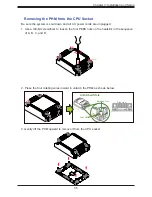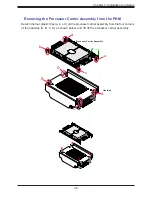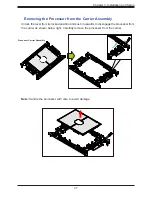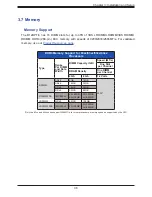
39
Chapter 3: Installation and Setup
Memory Population Guidelines
•
All DIMMs must be DDR4.
•
Balance memory. Using unbalanced memory topology, such as populating two DIMMs in
one channel while populating one DIMM in another channel, reduces performance. It is
not recommended for Supermicro systems.
•
In dual-CPU configurations, memory must be installed in the slots associated with the
installed CPUs. Also, an odd number of total DIMMs is not recommended.
•
For MM, NM/FM ratio is between 1:4 and 1:16. The capacity not used for FM can be used
for AD. (NM = Near Memory; FM = Far Memory).
Guidelines Regarding Mixing DIMMs
•
Populating slots with a pair of DIMM modules of the same type and capacity results in
interleaved memory, which improves memory performance.
•
Use memory modules of the same type and speed, as mixing is not allowed.
•
x4 and x8 DIMMs can be mixed in the same channel.
•
Mixing of LRDIMMs and RDIMMs is not allowed in the same channel, across different
channels, and across different sockets.
•
Mixing of non-3DS and 3DS LRDIMM is not allowed in the same channel, across different
channels, and across different sockets.
DIMM Construction
•
RDIMM (
non-3DS
) Raw Cards: A/B (2Rx4), C (1Rx4), D (1Rx8), E (2Rx8)
•
3DS RDIMM Raw Cards: A/B (4Rx4)
•
LRDIMM (
non-3DS
) Raw Cards: D/E (4Rx4)
•
3DS LRDIMM Raw Cards: A/B (8Rx4)
Memory Population Sequence
Blue slots versus black slots:
Install the first DIMM in the blue memory slot, which is the
first of a memory channel.
The following memory population sequence table was created based on guidelines provided
by Intel to support Supermicro motherboards.
















































